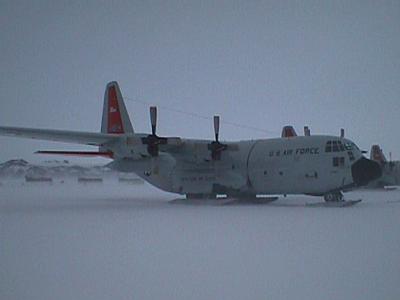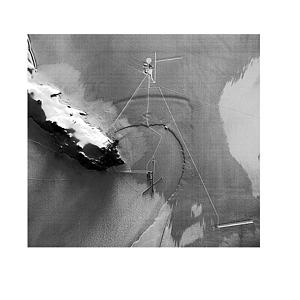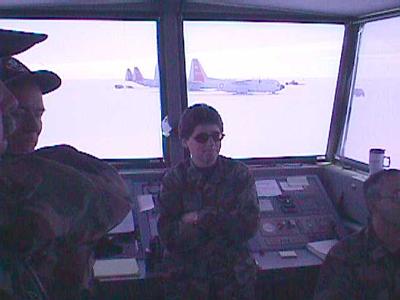
|
|
1 December, 1999
As the day for my departure draws closer, my thoughts quite naturally turn
towards thoughts of "How am I going to get out of here?". I flew from
Christchurch, New Zealand on October 16th in a C-141 Starlifter. This was a
wheeled aircraft that lands on the sea ice runway. Since then, the weather
has gotten warmer and the sea ice runway is not stable enough for the C-141
to land. The only aircraft that fly from New Zealand to McMurdo now are the
smaller C-130 Hercules aircraft. About 4 to 5 Hercs are deployed to
Antarctica by the 109th Airlift Wing of the New York Air National Guard. The
New Zealand Air Force also operates two wheeled C-130s between Christchurch
and Antarctica. Even though the planes of the 109th are ski-equipped, they
are presently landing with their wheels. About the middle of December the
sea ice will become too unstable to use at all and air operations will be
shifted to Williams Field. Willie Field is on the permanent ice shelf. It is
farther away from McMurdo, so travel time to and from the aircraft will be
increased. Due to the deep snow on the ice shelf, only the ski-equipped
C-130s of the Air National Guard will be able to support McMurdo. Still
later in the season, a third airfield, named Pegasus, is opened. This is
also on the ice shelf, but snow is cleared from the ice so wheeled aircraft
can land. This allows for larger amounts of personnel and equipment at the
end of the summer season.
As you can see, airplanes are a vital lifeline for the people in Antarctica.
Virtually all personnel and much of the needed supplies are brought in by
airplane. Large amounts of supplies are also brought in and removed by ships
that start arriving at McMurdo in January. A Coast Guard icebreaker clears a
passage from the open sea to the harbor at McMurdo Station. A tanker arrives
to refill the fuel storage tanks for the year. A cargo ship, the "Green
Wave", arrives in late January to off load supplies for the year and remove
the garbage, recycled trash as well as scientific samples and equipment. The
name for the logistical operation that supports the science efforts in
Antarctica is called "Operation Deep Freeze". ODF used to be coordinated
entirely by the U.S. Navy. The operation now involves a combination of U.S.
military and civilian organizations along with the support of other
countries like New Zealand and Italy.
Right now, the 109th and the New Zealand Air Force supply the only airlink
to between New Zealand, McMurdo and the South Pole. They fly 5 to 6 missions
a day, weather permitting, including two to the South Pole. They also fly
missions to remote field camps all over the continent. Many of the men and
women of the 109th are Air Guard personnel who come to Antarctica for about
2-3 weeks. They work at regular jobs the rest of the year and fulfill their
commitment to the Air Guard on a part time basis. Many of the Herc pilots
are commercial airline pilots. I had the opportunity to tour the Air Guard
Headquarters and go out to the ice runway. Many of the people working on the
ice with the 109th have been here before. This is considered a good
assignment because of the uniqueness and the natural beauty. The New York
Air National Guard takes great pride in the fact that they are the only
ski-equipped aircraft fleet in the world. They often fly supplies to
Antarctic bases for other countries. They supply the Russian base at Vostok
Station and have been for quite some time. It takes a great deal of training
to learn how to fly in the special conditions of Antarctica and land a
ski-equipped Herc. Even an experienced Herc pilot requires an additional two
years of training before she or he can pilot a mission on the ice.
Unpredictable weather, white outs, and untested landing areas are just some
of the problems that pilots must deal with. After the austral summer flying
season ends, usually in February, the 109th starts preparing for missions on
another ice-covered landmass, Greenland.
I am confident that the people of the 109th will make my flight off the
continent a safe one, if not short or comfortable. Now, if they could only
do something about the weather.
Those of you who have been running the evaporation experiment, here
is my final set of data for the experiment I ran in Antarctica. Because the
last set of data I sent out in table form did not come out right, I am going
to present the data this time as ordered pairs. I am listing the time
elapsed since the beginning of the experiment first followed by the depth of
the water in the pan, (Time Elapsed (hr), Average Depth (mm)). I would
suggest you graph this data and compare the rate of evaporation that I got
with the rate that you determined. Your math teacher can help you determine
how to graph this data and determine the evaporation rate.
Evaporation Experiment Data, November 11 though December 1, 1999, McMurdo
Station, Antarctica
Average temperature of the water = 63F
Data
(0,35), (26,35), (45,33), (62,32), (86,31), (110, 30), (134,28), (158,27),
(172,26), (196,24), (218,23), (254,21), (266,21)

A C-130 Hercules aircraft sitting on the ice runway on the Ross Sea on a snowy, windy day.

This is a nice satellite image showing the locations of the three airfields used by aircraft landing at McMurdo. The sea ice runway is the one in the center of the image, just off the Hut Point Peninsula. Towards the top of the image is Williams Field and in the lower right hand corner is Pegasus. Note the location of the edge of the permanent ice sheet.

Here is a close-up of the landing gear of the C-130's. They are capable of landing on wheels or skis.

The operations of the sea ice runway are monitored from the control tower on the ice.

This is the ice pier in Winter Quarters Bay at McMurdo Station. It is frozen over now, but beginning in January, ships will begin arriving to supply the station for the season.

Four Hercs waiting on the ice during a snow storm. One of these aircraft will be taking me off the ice in a just a few days.
Contact the TEA in the field at
.
If you cannot connect through your browser, copy the
TEA's e-mail address in the "To:" line of
your favorite e-mail package.
|
